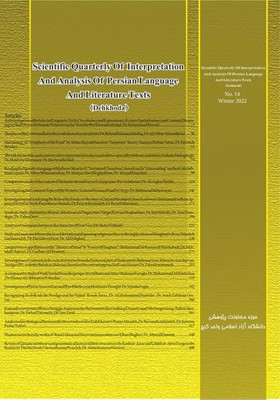Symbolic study of animals in Moin al-ddin Jovayni's Negarestan
Subject Areas : Historical (with literary and artistic features)Narges Rezvani Moghadam 1 , Iraj Mehraki 2 , Azar Daneshgar 3 , Zahra Dorri 4
1 - Ph.D. student, Department of Persian Language and Literature, Karaj Branch, Islamic Azad University, Karaj, Iran.
2 - Associate Professor, Department of Persian Language and Literature, Karaj Branch, Islamic Azad University, Karaj, Iran.
3 - Assistant Professor, Department of Persian Language and Literature, Karaj Branch, Islamic Azad University, Karaj, Iran.
4 - Assistant Professor, Department of Persian Language and Literature, Karaj Branch, Islamic Azad University, Karaj, Iran.
Keywords: symbol, animals, Moin al-ddin Jovayni, Negarestan,
Abstract :
Symbols often originates from nature, national and mythological rituals, and religion and are one of the methods of communicating and conveying meanings. The words in addition of its true meaning, evoke multiple and even contradictory meanings and images that to be aroused different emotional reactions and feelings in the reader. In Persian literature, from the names of all kinds of animals have been used in various cases and in different meanings. Animals whose names are sometimes be applied in the real sense and sometimes in the unreal and symbolic sense. In this research, the symbolic study of animals is discussed in the book of Jovayni's Negarestan. Animals have been divided from the direction of symbolic meaning and real meaning, and the frequency of each item is also provided. Moin al-ddin Jovayni's Negareatan is a book written in imitation of Saadi's Golestan. The study method is based on theoretical principles and descriptive-analytical method and research tools, has been books and Information and library resources in this area. In compiling the desired contents due to the multiplicity and diversity of different species of animals, they are divided into four groups: ((livestock)), ((birds)), ((insects and vermin)); and ((aquatic)) and has been brought explanations and documents on their symbolic concepts in each group. The aim of writing the research was to find out what symbolic meanings the animals in Moin al-ddin Jovayni's Negarestan were used and to determine the frequency of each. The result of this study reveals that Jovayni has used in respectively from animals, birds, insects and vermin and aquatic animals in the symbolic and real meanings. The amounts of application of real concepts is more in all kinds, and in insects and vermin, symbolic meanings and real concepts are almost equal.
کتابها
پورنامداریان، تقی (1383) رمز و داستانهای رمزی در ادب فارسی، تهران: علمی و فرهنگی.
تهرانی، شیخ آقا بزرگ (1408ه.ق) الذریعه إلی تصانیف الشیعه، جلد 25، قم: اسماعیلیان/ تهران، کتابخانۀ اسلامیه.
جوینی، معینالدین (1398) نگارستان، تصحیح علی اکبر عباسآبادی، هادی عباسآبادی، نرگس رضوانیمقدم، طبس: انتشارات فراونگ.
خالقی مطلق، جلال (2536) اساس اشتقاق فارسی، تهران: بنیاد فرهنگ ایران.
داد، سیما (1390) فرهنگ اصطلاحات ادبی، واژهنامه، مفاهیم و اصطلاحات ادبی فارسی و اروپایی، جلد 5، تهران: مروارید.
دادگی، فرنبغ (1385) بندهش، گزارش مهرداد بهار، تهران: توس.
دوستخواه، جلیل (1385) اوستا، کهنترین سرودهای ایرانیان، تهران: مروارید.
دولتشاه سمرقندی، امیر (1366) تذکرة الشّعرا، به کوشش محمّد رمضانی، تهران: انتشارات پدیدۀ خاور.
رضی، هاشم (1385) وندیداد، تهران: بهجت.
شریفی، محمّد (1387) فرهنگ ادبیّات فارسی، تهران: انتشارات فرهنگ نشر نور معین.
عطوفت شمسی، مسعود (1387) دایرةالمعارف حیوانات ایران، تهران: بدرقۀ جاویدان.
فتوحی، محمود (1386) بلاغت تصویر، تهران: سخن.
قلیزاده، خسرو (1387) فرهنگ اساطیر ایرانی، بر پایۀ متون پهلوی، تهران: کتاب پارسه.
کوپر، جی. سی (1392) فرهنگ نمادهای آیینی، ترجمه رقیه بهزاد، تهران: علمی.
معین، محمد (1386) فرهنگ فارسی معین، جلد 1 تا 4، تهران: نامن.
مقالات
ذاکری، احمد، جماران، فایزه. (1389). حیوانات در آثار سعدی. تفسیر و تحلیل متون زبان و ادبیات فارسی (دهخدا)، 2(6)، 29-56.
منزوی، احمد. (1352). تتبّع در گلستان سعدی. نشریه وحید، 11(5)، 552-556.
پایاننامهها
ایاز، حمید (1396) بررسی تطبیقی مفاهیم نمادین جانوران در متون حماسی، غنایی و عرفانی با تکیه بر شاهنامۀ فردوسی، خمسۀ نظامی و مثنوی معنوی مولوی، دانشگاه آزاد اسلامی واحد تهران جنوب.
_||_Books
Cooper, J. C (2013) Culture of Ritual Symbols, translated by Roghayeh Behzādi, Tehran: Elmi publications.
Dād, Simā (2011) Dictionary of Literary Terms, Dictionary, Persian and European Literary Concepts and Terms, Volume 5, Tehran: Morvārid Publications.
Dādegi, Farnbagh (2006) Bondahesh, Report by Mehrdad Bahar, Tehran: Ṭoos. Publications.
Dolatshāh Samarqandi, Amir (1987) Tazkereh al-Sho ͨarā, by Mohammad Ramezani, Tehran: Padideh Khāvar Publications.
Dostkhāh, Jalil (2006) Avestā, the oldest Iranian songs, Tehran: Morvārid Publications.
Fotouḥi, Maḥmoud (2007) Rhetoric of Image, Tehran: Sokhan publications.
Gholizādeh, Khosrow (2008) Culture of Persian mythology, based on Pahlavi texts, Tehran: Ketāb-e- pārseh publications.
Jovayni, Mo ͨineddin (2020) Negārestān, edited by Ali Akbar ͨAbbāsābādi, Hādi ͨAbbāsābādi, Narges Rezvāni Moghaddam, Ṭabas: Farāvang Publications.
Khāleghi Motlagh, Jalāl (2536) Basis of Persian Derivation, Tehran: Bonyād-e- Farhang-e- Iran pubications.
Mo ͨein, Moḥammad (2007) Persian Culture, vols. 1 to 4, Tehran: Nāmen publications.
ͨ Otoofat Shamsi, Mas ͨoud (2008) Encyclopedia of Iranian Animals, Tehran: Badragha-e-Jāvidān publications.
Pournāmdarian, Taghi (2004) Mysteries and Mysterious Stories in Persian Literature, Tehran: ͨElmi va Farhangi Publications.
Razi, Hāshem (2006) Vandidād, Tehran: Behjat Publications.
Sharifi, Mohammad (2008) Dictionary of Persian Literature, Tehran: Farhang-e- Nashr-e- Noor-e- Moin Publications.
Tehrāni, Sheikh Aghā Bozorg (1976) Al-dhari ͨah elā tasānif al-Shi ͨ a, vol. 25, Qom, Ismāiliān / Tehran: ketābkhāney-e- islāmiyeh.
Articles
Jamārān, Fāizeh; Zakeri, Aḥmad. (2011). Animals article in Sa ͨdi's works. Interpretation and Analysis of Persian Language and Literature Texts (Dehkhoda), 2(6), 29-56.
Monzavi, Ahmad. (1973). Research in Golestān Sa ͨdi. Vahid Journal, 11(5), 552-556.
Theses
Ayāz, Ḥamid, (2018), A Comparative Study of Symbolic Concepts of Animals in Epic, Lyrical and Mystical Texts Based on Ferdowsi's Shahnameh, Khamseh Nezami and Molavi's Spiritual Masnavi, Islamic Azād University, South Tehran Branch.


